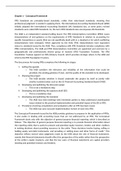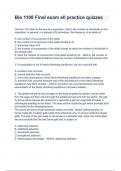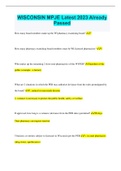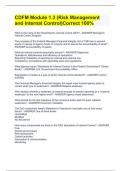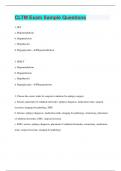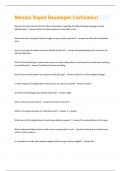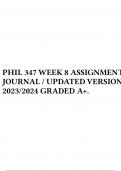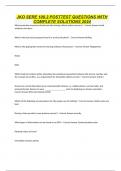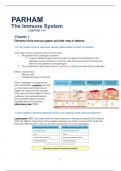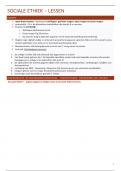IFRS Standards are principles-based standards, rather than rules-based standards, meaning that
professional judgment is needed in applying them. The International Accounting Standards Board (IASB)
initially adopted the International Accounting Standards (IAS Standards) but, at some point, revised
standards were called IFRS Standards. So, the term IFRS Standards also encompasses IAS Standards.
The IASB is an independent standard-setting board. The IFRS Interpretations Committee (IFRIC) issues
interpretations of and guidance on the requirements of IFRS Standards in relation to accounting for
specific transactions or events (that are not specifically dealt with in a standard or for which conflicting
interpretations have emerged). When approved by the IASB, IFRIC Interpretations have equivalent
status to standards issued by the IASB. Thus, compliance with IFRS Standards includes compliance with
IFRIC Interpretations. The IASB and IFRS Interpretations Committee are appointed and overseen by a
geographically and professionally diverse group of trustees (IFRS Foundation Trustees). The IFRS
Foundation Trustees appoint an IFRS Advisory Council, which provides strategic advice to the IASB and
informs the IFRS Foundation Trustees.
The due process for issuing IFRSs comprises the following six stages:
1. Setting the agenda.
o The IASB considers the relevance and reliability of the information that could be
provided, the existing guidance (if any), and the quality of the standard to be developed.
2. Planning the project.
o The IASB decides whether it should undertake the project by itself or jointly with
another standard setter such as the US Financial Accounting Standards Board (FASB).
3. Developing and publishing the discussion paper.
o This is not a mandatory step.
4. Developing and publishing the exposure draft (ED).
o This is a mandatory step.
5. Developing and publishing the standard.
o The IASB may hold meetings with interested parties to help understand unanticipated
issues related to the practical implementation and potential impact of the ED or IFRS.
6. Procedures involving consultations and evaluations after an IFRS has been issued.
o The IASB may carry out post-implementation reviews of each new IFRS.
The Conceptual Framework issued by the IASB provides guidance to prepares in the application of IFRSs.
It also assists in dealing with accounting issues that are not addressed by an IFRS. The Conceptual
Framework deals only with the objective of general purpose financial reporting, which is described as
follows: “The objective of general purpose financial reporting is to provide financial information about
the reporting entity that is useful to present and potential equity investors, lenders and other creditors
in making decisions about providing resources to the entity. Those decisions involve buying, selling or
holding equity and debt instruments, and providing or settling loans and other forms of credit.” This
objective reflects several value judgments made by the IASB about the role of financial statements,
namely that financial statements should reflect the perspective of the entity rather than the perspective
of the entity’s equity investors, and that the key users of financial statements are capital providers
(existing and potential investors and lenders).
,For financial information to be decision useful, it must possess two fundamental qualitative
characteristics:
Relevance. Information is relevant if (1) it is capable of making a difference in the decisions
made by the capital providers as users of financial information, (2) it has predictive value (it
affects expectations), confirmatory value (it confirms or changes past or present expectations
based on previous evaluations), or both, and (3) it is capable of making a difference whether the
users use it or not. The notion of capability in the third item implies that it is not necessary that
the information has actually made a difference in the past or will make a difference in the
future.
o Materiality is an entity-specific aspect of the relevance of information. Information is
material if its omission or misstatement could influence the decisions that users make
about a specific reporting entity.
Faithful representation. Faithful representation is attained when the depiction of an economic
phenomenon is (1) complete (it includes all information necessary for faithful representation),
(2) neutral (bias intended to attain a predetermined result is absent), and (3) free from material
error.
o It may be necessary to disclose information about the degree of uncertainty in the
information in order that the disclosure attains faithful representation.
The Conceptual Framework identifies four enhancing qualitative characteristics, which complement the
fundamental characteristics and which distinguish more useful information form less useful information:
Comparability is the quality of information that enables users to identify similarities in and
differences between two sets of economic phenomena.
Verifiability is a quality of information that helps assure users that information faithfully
represents the economic phenomena that it purports to represent.
Timeliness means having information available to decision makers before it loses its capacity to
influence decisions.
Understandability is the quality of information that enables users to comprehend its meaning.
Alternative accounting policies exist in the treatment of many items, but an entity must select and apply
its accounting policies in a consistent manner from one period to another. Any change made in an
accounting policy by an entity must be disclosed by stating the nature of the change, the reasons the
change provides reliable and more relevant information, and the effect of the change in monetary terms
on each financial statement affected.
The Conceptual Framework also notes that cost is the constraint that limits the information provided by
financial reporting. The benefits of supplying information should always be greater than the costs.
Financial statements are prepared under the assumption – referred to as the going concern assumption
– that the entity will continue to operate for the foreseeable future; at least long enough to carry out its
existing commitments.
The Conceptual Framework identifies and defines five elements of financial statements:
An asset is a resource controlled by the entity as a result of past events and from which future
economic benefits are expected to flow to the entity.
, A liability is a present obligation of the entity arising from past events, the settlement of which is
expected to result in an outflow from the entity of resources embodying economic benefits.
Equity is the residual interest in the assets of an entity after deducting all its liabilities.
Income are increases in economic benefits during the accounting period in the form of inflows
or enhancements of assets or decreases of liabilities that result in increases in equity, other than
those relating to contributions from equity participants.
o Under the Conceptual Framework, income encompasses both revenue and gains.
Revenue is defined as the gross inflow of economic benefits during the period arising in
the course of the ordinary activities of an entity when those inflows result in increases in
equity, other than increases relating to contributions from equity participants. Thus,
revenue represents income which has arisen from the ordinary activities of an entity,
whereas gains represent income that does not necessarily arise from the ordinary
activities of the entity (such as gains on the disposal of non-current assets).
Expenses are decreases in economic benefits during the accounting period in the form of
outflows or depletions of assets or incurrences of liabilities that result in decreases in equity,
other than those relating to distributions to equity participants.
o Under the Conceptual Framework, expenses also encompass losses, which are expenses
that may not arise in the ordinary course of the entity’s activities.
An asset should be recognized in the statement of financial position when it is probable that the future
economic benefits will flow to the entity and the asset has a cost or other value that can be measured
reliably. A liability is recognized in the statement of financial position when it is probable that an outflow
of resources embodying economic benefits will result from settling the present obligation and the
amount at which the settlement will take place can be measured reliably.
Income is recognized in the statement of profit or loss and other comprehensive income when an
increase in future economic benefits relating to an increase in an asset or a decrease in a liability can be
measured reliably. As with the recognition criteria for assets and liabilities, probability of occurrence and
reliability of measurement are presented as the two criteria for income recognition. In addition to the
probability criteria for expense recognition, expenses are recognized in the statement of profit or loss
and other comprehensive income when a decrease in future economic benefits related to a decrease in
an asset or an increase in liability can be measured reliably.
Chapter 3 – Fair Value Measurement
Prior to 2011, various accounting standards provided guidance on the measurement of fair value.
However, despite this, there was generally limited guidance in IFRS Standards on how to measure fair
value and, in some cases, the guidance was conflicting. The IASB wanted to establish a single source of
guidance for all fair value measurements required or permitted by IFRSs to reduce complexity and
improve consistency in their application. It addition to that, it wanted to clarify the definition of fair
value and related guidance in order to communicate the measurement objective more clearly. For this
purpose, the IASB undertook a convergence project with the US FASB, which resulted in the issuance of
IFRS 13 Fair Value Measurement, in May 2011. Note that the IASB was not proposing to introduce new
requirements for the use of fair value as the required measurement method. The objectives of IFRS 13
, are to define fair value, to set out in a single standard a framework for measuring fair value, and to
require disclosures about fair value measurement.
IFRS 13 defines fair value as follows: “The price that would be received to sell an asset or paid to transfer
a liability in an orderly transaction between market participants at the measurement date.” When an
entity acquires an asset or assumes a liability in an exchange transaction, the transaction price is the
amount paid by the entity: this is an entry price. In contrast, the fair value of the asset or liability is the
price that would be received to sell the asset or paid to transfer the liability: this is an exit price.
Importantly, the definition of fair value is that it is an exit price based on the perspective of the entity
that holds the asset or owed the liability. An exit price is based on market participants’ expectations
about the future cash flows that will be generated by the asset subsequent to the sale oof the asset or
transfer of the liability. The fair value is not influenced by whether or not the entity intends to use
(rather than sell) the asset or to continue to hold (rather than transfer) the liability: fair value is
measured by considering a hypothetical transaction in the market.
The definition of fair value requires that an asset be sold or a liability transferred in an orderly
transaction, which is not a forced or distressed sale (such as occurs in liquidations). Similarly, prices
between entities that are not at arm’s length are not prices from orderly transactions. IFRS 13 is clear
that fair value remains a market-based exit price that considers the current market conditions at the
measurement date, even if there has been a significant decrease in the volume and level of activity for
the asset or liability. Additional guidance is provided to assist entities in measuring fair value when the
volume or level of activity for an asset or a liability has significantly decreased.
Both transaction costs (incremental direct costs, that are essential to the transaction, that would be
incurred in the principal or most advantageous market and are directly attributable to the sale or
transfer) and transport costs (costs that would be incurred to move the asset to the principal or most
advantageous market) affect the determination of fair value of an asset or liability. For instance, when
determining the most advantageous market (in the absence of a principal market), an entity takes into
consideration the transaction costs and transportation costs it would incur to sell the asset or transfer
the liability. However, the price used to measure fair value is not adjusted for transactions costs, but
would consider transportation costs. The reason why the price in the market that is used to measure the
fair value is not adjusted for transaction costs, is that transaction costs are not considered to be a
characteristic of the asset or liability. Instead, they are specific to a transaction and will change from
transaction to transaction.
When measuring fair value, IFRS 13 requires an entity to determine all of the following:
The particular asset or liability that is the subject of the measurement (consistent with its unit of
account).
o In order to measure fair value for a particular asset or liability, an entity must take into
account those characteristics that exit at the measurement date that a market
participant would consider when pricing the asset or liability. Some of the key questions
that need to be asked when determining the asset or liability to be measured are: What
is the unit of account (the level at which an asset or a liability is aggregated or
disaggregated in an IFRS for recognition purposes; think of single assets versus cash-
generating units)? Is the asset a stand-alone asset or is it a group of assets? Are there


